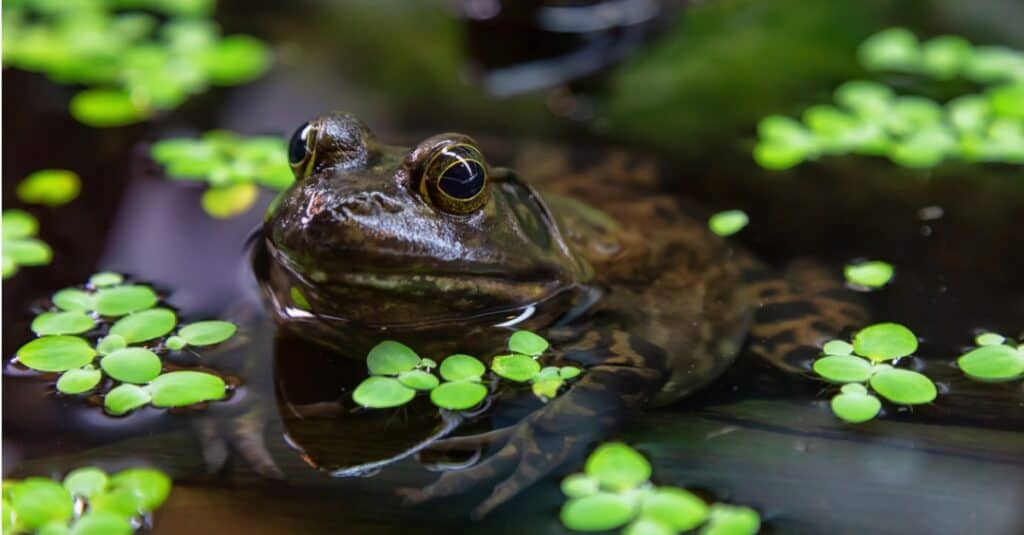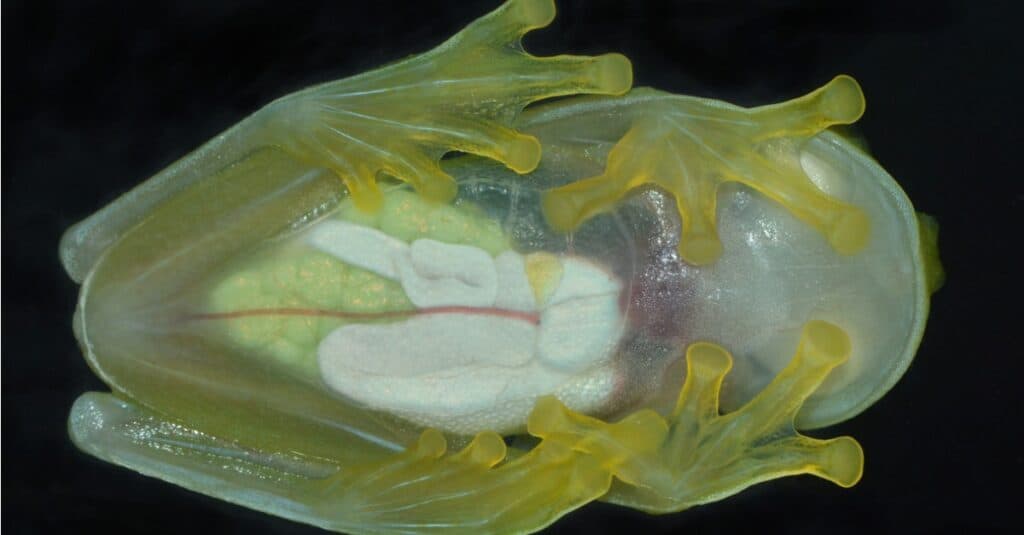Have you ever heard of ‘see-through’ or ‘invisible’ frogs? Well, the truth is a little more mundane, but glass frogs are still a fascinating species! But how did this unusual group of amphibians get their name and stealthy reputation?
Read on to learn more about the beautiful yet fragile glass frog and its incredible transparent skin below. We’ll go over why these frogs have visible viscera and what its possible evolutionary benefits are. You might also be surprised to learn that transparent skin is actually not completely unheard of in the animal kingdom!
What Are Glass Frogs?

Beautiful yet fragile, glass frogs have completely transparent skin on their abdomens!
©Agami Photo Agency/Shutterstock.com
Glass frogs are a group of more than 100 species within the Centrolenidae family. They mostly inhabit moist, heavily forested areas of Central and South America. Notably, the skin around the frog’s abdomen is transparent, meaning its internal organs are clearly visible under certain lighting.
Overall, glass frogs tend to be very small at only around one to two inches in length. They have very large eyes with typical horizontal pupils and very light green translucent to transparent skin. They are arboreal, meaning they primarily dwell in tall trees. Aside from their yearly mating season, glass frogs rarely come out from their hiding spots and are extremely reclusive. They are primarily carnivorous and mostly feed upon small insects.
These handsome little frogs reproduce sexually and use external fertilization. Typically, a female will lay her eggs on the underside of a moist leaf above a body of water, and a male will release his sperm onto the eggs and fertilize them soon afterward. Interestingly, glass frogs display some parental care towards their young, which is rare amongst frogs! In many cases, the females will lay on their eggs to protect them, and even the males will sometimes guard them both.
Once the glass frogs’ eggs hatch, the tadpoles fall from the leaves and into the water, usually a pond or a stream, underneath. Once they develop into froglets, they begin to climb into the surrounding trees, where their arboreal lifestyle repeats once more with a new generation of tiny, see-through frogs.
As far as defense mechanisms go, glass frogs are extremely fragile. However, their skin color and transparency actually give them a unique method of camouflage, which we’ll cover in more detail below!
Why Are Glass Frogs Transparent?

Most frogs like this
bullfrog
have dark brown and green colors to blend in with their habitats. Glass frogs’ means of camouflage are a bit more complex.
©iStock.com/edb3_16
The main reason why glass frogs are transparent is to protect themselves via camouflage. While most of their bodies are translucent or opaque, their undersides are almost completely transparent. The coloration of their bodies and legs allows them to blend in very well with the surrounding fauna in their native rainforest habitats.
For many years, researchers struggled to understand why glass frogs’ skin had evolved in such an unusual way. Eventually, they found that glass frogs were attacked by predators less often than other species thanks to their see-through skin!
The frogs’ stealthiness can mostly be attributed to a phenomenon known as edge diffusion. Essentially, while most of the glass frog’s body is opaque or translucent, its legs are almost entirely transparent. When a glass frog is resting on a leaf or a branch, its legs blend in almost seamlessly with its surroundings! This creates the illusion of a softer “edge” around the frog’s body, making it harder for predators to spot them.
Even the glass frog’s most eagle-eyed predators struggle to locate them in the wild! This makes the frogs’ transparent skin a valuable defense mechanism, as they are otherwise quite weak and defenseless.
Are Glass Frogs Good Pets?

Glass frogs are extremely fragile and should only be kept as pets by experts.
©iStock.com/Maria Ogrzewalska
Glass frogs aren’t very popular in the pet trade. This is mostly due to how specialized their care must be in captivity and how fragile they are when it comes to illnesses and injuries. However, with the correct setup, it is possible for a knowledgeable and responsible owner to raise them properly.
Because of the glass frog’s reclusive nature, it is very difficult to collect them from their natural habitats. They often inhabit hard-to-reach areas along fast-moving, rocky streams that are nearly inaccessible to humans. Additionally, many species are critically endangered due to habitat loss. This can make them somewhat expensive to purchase and house properly.
However, some herpetology hobbyists greatly enjoy caring for glass frogs and consider them to be very rewarding pets. With the right humidity and temperature settings and plenty of plant cover for privacy, they can thrive in captivity. Still, because of their very specific care needs and fragile nature, these see-through frogs should not be kept by beginner amphibian hobbyists.
Do Any Other Animals Have Transparent Skin?

Like the glass frog, the fragile
jellyfish
also uses transparency to its advantage.
©iStock.com/GaryKavanagh
Glass frogs aren’t the only animals that have evolved to have translucent or entirely transparent skin! Many other animals have developed see-through skin over time, such as jellyfish and glass octopuses. Similar to the glass frog, these animals mostly use their skin as a means of camouflage to hide from predators.
Interestingly, a handful of terrestrial and aquatic animals have also evolved to have transparent skin! Animals such as glasswing butterflies, glass octopuses and squids, and many species of jellyfish are also very difficult to spot in their native habitats. This is largely thanks to their skin that makes them look nearly invisible!
For the most part, researchers believe animals use this unique adaptation to hide from predators. However, some animals like the glass octopus likely also use it to sneak up on their prey! Either way, transparent skin is quite useful to various species within the animal kingdom.
The photo featured at the top of this post is © iStock.com/Maria Ogrzewalska
Thank you for reading! Have some feedback for us? Contact the AZ Animals editorial team.






